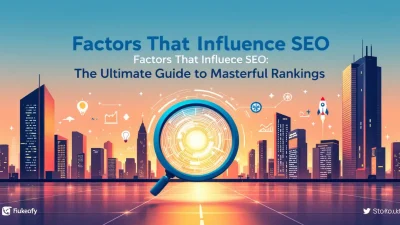In the digital marketing arena, understanding the difference between SEO and SEM can be the key to unlocking your brand’s success. Are you leveraging organic growth strategies or is your focus on paid visibility? The distinction is more than just budgetary—it affects your entire marketing strategy.
In this comprehensive guide, we’ll delve deep into the core contrasts between these two pivotal parts of online marketing. Whether you’re a seasoned digital marketer or a curious newcomer, grasping these 7 key distinctions could redefine how you approach your campaigns.
Let’s embark on this exploration, drawing a line in the digital marketing sand, to distinguish what truly makes SEO stand apart from SEM.
Table of Contents
- SEO Basics: The Organic Approach
- SEM Overview: The Pay-to-Play Strategy
- Key Distinction #1: Cost Implications
- Key Distinction #2: Traffic Acquisition
- Key Distinction #3: Time to Impact
- Key Distinction #4: Long-term vs. Short-term Results
- Key Distinction #5: Analytical Tools and Measures
- Key Distinction #6: Strategy Flexibility
- Key Distinction #7: Brand Visibility and Credibility
- FAQs
- Conclusion: Weighing Up SEO and SEM for Your Business
SEO Basics: The Organic Approach
Grasping the difference between SEO and SEM begins with understanding the fundamentals of SEO itself. SEO, or Search Engine Optimization, focuses on enhancing a website’s visibility through organic means. Unlike SEM, which involves paid strategies, SEO relies on optimizing content, improving website architecture, and building natural backlinks.
Core Elements of SEO
- On-Page Optimization: This involves refining individual pages to rank higher and earn more relevant traffic. Effective use of keywords, meta tags, and quality content are crucial.
- Off-Page SEO: Building authority through backlinks and leveraging social media presence are key. High-quality backlinks from trusted sites significantly impact organic ranking.
- Technical SEO: Ensures your site is crawlable and indexable by search engines. Factors include optimized site speed, mobile-friendliness, and an XML sitemap.
SEO Strategies and Benefits
SEO offers long-term growth by driving sustained organic traffic. Understanding the seo vs sem marketing landscape helps to align your strategies effectively.
- Sustainability: Once a page ranks well, it can continue to attract traffic without ongoing ad spend.
- Credibility and Trust: High organic rankings build trust with users, unlike paid ads, which are often regarded with skepticism.
| Aspect | SEO |
|---|---|
| Cost | Generally low; focuses on organic growth |
| Longevity | Long-term with sustained benefits |
For a deeper dive into optimizing your SEO strategy, explore the Backlinko SEO Hub and the Ahrefs Blog on SEO vs SEM. Knowing the seo and sem difference empowers you to leverage each for optimal results.
SEM Overview: The Pay-to-Play Strategy
Delving into the difference between SEO and SEM, it’s essential to understand that SEM (Search Engine Marketing) represents a pay-to-play strategy. While SEO focuses on organic visibility, SEM involves paid tactics to earn prominent spots in search engine results pages (SERPs). When you think of SEO vs SEM marketing, imagine a race car driver with a robust engine (SEO) versus one that uses turbo boosts (SEM) to speed ahead.
Unlike SEO, where results can take time, SEM promises immediate visibility. It’s as if you’re flipping on a light switch that instantly illuminates your brand. This tactic is perfect for businesses that need quick wins or those launching new products. Mastering search rankings is crucial, whether through SEO or SEM.
Advantages of SEM
- Quick Results: By utilizing platforms like Google Ads, you can see an increase in traffic almost instantly.
- Targeted Reach: SEM allows precise audience targeting, ensuring you reach users actively searching for your products or services.
- Measurable ROI: Trackable data helps you adjust your strategy and maximize returns.
Key benefit: Having control over your advertising spend and targeting with SEM.
Consider marketing experts who endorse a mix of both SEO and SEM for a holistic approach. For further comparison between these strategies, visit this comprehensive guide.
| SEO Feature | SEM Feature |
|---|---|
| Organic Growth | Paid Ads |
| Long-Term Strategy | Short-Term Boost |
By understanding the SEO and SEM difference, you can align your digital marketing efforts with your business goals more effectively.
Key Distinction #1: Cost Implications
When you delve into the difference between SEO and SEM, one of the main factors to consider is cost. Understanding this distinction is crucial for your marketing budget allocation.
SEO, or Search Engine Optimization, focuses on enhancing organic traffic. It’s often cost-effective in the long run but requires an initial investment of time and effort. Your main expenses involve creating high-quality content and optimizing on-page elements. This approach can yield lasting results with potential growth in organic search rankings over time.
On the other hand, SEM, or Search Engine Marketing, includes paying for ads to appear in search engine results. This method provides immediate visibility, but costs can add up quickly as you pay per click. While SEM offers quick results, it’s essential to continuously fund campaigns to maintain visibility. For a deeper dive into these strategies, consider reading more on Backlinko, Ahrefs, and Digital Marketing Institute.
| Aspect | SEO | SEM |
|---|---|---|
| Cost Type | Long-term investment | Pay per click |
| Timeframe | Gradual Improvement | Instant Visibility |
Ultimately, the choice between SEO and SEM depends on your business goals, timeframe, and budget. Weigh these cost implications carefully to optimize your strategy.
Key Distinction #2: Traffic Acquisition
When discussing the difference between SEO and SEM, traffic acquisition plays a pivotal role. Understanding how each strategy drives traffic is crucial for leveraging their strengths.
SEO: Search Engine Optimization focuses on organic traffic—users naturally discovering your website through search results without paid promotion. SEO efforts, like optimizing keywords and creating high-quality content, build long-term value. For an in-depth guide on mastering search rankings, explore our SEO Tutorial.
SEM: Search Engine Marketing involves paid strategies to acquire traffic swiftly. Through SEM campaigns, ads appear in search engine results, driving immediate visibility and traffic. While this method demands investment, results are rapid, which can complement SEO efforts over time. Learn more about SEO vs. SEM marketing.
Fast traffic acquisition is a distinct advantage of SEM, contrasting with the sustainable growth from SEO strategies.
For further comparisons, consider resources at Ahrefs and Digital Marketing Institute. By understanding these differences, businesses can devise a strategy utilizing both SEO and SEM effectively.
Key Distinction #3: Time to Impact
When pondering the difference between SEO and SEM, the time each takes to yield results is pivotal. Understanding this facet is crucial for strategists choosing between SEO vs SEM marketing.
SEO: Building an organic presence through SEO efforts is a marathon, not a sprint. The impact of SEO is gradual, requiring months of diligent optimization and strategic content development. While the climb is steady, the rewards in the form of consistent organic traffic can pay off long-term. Check out our SEO Tutorial for mastering these nuanced skills.
SEM: Conversely, SEM is the quick fixer-upper. By employing paid strategies, results are near-instantaneous. The boost in visibility can happen almost overnight, making SEM the choice for those needing immediate impact.
Key benefit: SEM offers fast visibility while SEO provides sustainability.
Balancing both can be strategic: Use SEM for immediate benefits and SEO for sustainable growth. Interested in more insights? The integration of SEO and SEM is a game-changer in digital strategies.
Key Distinction #4: Long-term vs. Short-term Results
When exploring the difference between SEO and SEM, understanding their timelines for delivering results is crucial. SEO is a long-term strategy, gradually building organic traffic through consistent optimization efforts. It might take months for SEO to show significant impact, but the benefits are enduring and cost-effective. For a detailed guide on mastering SEO, check out our SEO Tutorial: The Ultimate Guide to Master Search Rankings.
On the other hand, SEM focuses on short-term results. By leveraging paid advertising, SEM delivers immediate exposure and instant traffic. This tactic is perfect for targeted campaigns or time-sensitive offers. However, reliance on SEM means ongoing expenses to maintain visibility.
SEO builds a foundation; SEM accelerates growth.
Choosing between SEO vs. SEM marketing largely depends on your business goals and desired timeline. Do you seek sustained growth, or is prompt action your priority? Understanding these dynamics helps in crafting a balanced strategy that leverages both strengths. For more insights on how these methods complement each other, explore SEO and SEM difference comprehensively.
Key Distinction #5: Analytical Tools and Measures
Understanding the difference between SEO and SEM means grasping the distinct ways we measure success in these strategies. While both are critical in digital marketing, they employ different analytical tools to evaluate performance effectively.
| Metric | SEO | SEM |
|---|---|---|
| Tools | Google Analytics, Ahrefs, Moz | Google Ads, SEMrush, SpyFu |
| Focus | Organic Traffic, Backlinks | Conversion Rate, CTR |
| Timing | Long-term Tracking | Immediate Results |
In SEO vs SEM marketing, SEO relies on tools like Ahrefs to track search rankings and backlinks, focusing on sustained organic growth. Conversely, SEM uses platforms such as Google Ads to monitor paid campaigns and conversion success quickly. This immediate insight into campaigns enables marketers to adjust strategies swiftly for optimal performance.
SEO and SEM difference in analytics pivots on timing and tools aimed at either long-term growth or rapid campaign success.
Considering these analytical variances is crucial when selecting the right approach for your marketing needs.
Key Distinction #6: Strategy Flexibility
When discussing the difference between SEO and SEM, strategy flexibility is where these two diverge significantly. SEO requires a long-term commitment, focusing on building organic search results over time. On the other hand, SEM offers more immediate results through paid search efforts, allowing marketers to adapt swiftly based on performance data.
| Aspect | SEO | SEM |
|---|---|---|
| Timeline | Long-term focus | Short-term adjustments |
| Budget | Organic efforts | Paid campaigns |
| Flexibility | Gradual changes | Quick pivots |
When choosing between SEO vs SEM marketing, consider how flexible you need your strategy to be. SEM’s quick adaptability can be crucial for short-term campaigns. For a comprehensive comparison, explore resources like Backlinko’s Guide to SEO vs SEM. Additionally, the differences are elaborated in detail by Ahrefs and the Digital Marketing Institute for deeper insights.
Key Distinction #7: Brand Visibility and Credibility
When comparing the difference between SEO and SEM, brand visibility and credibility emerge as crucial factors. SEO and SEM influence how audiences perceive your brand but in distinct ways. Let’s dive deeper into how each impacts these aspects.
- SEO: SEO strategies aim to build brand credibility over time. When your site ranks organically on search engines, it signals trustworthiness and authority to users. As a result, users are likely to perceive your brand as legitimate and valuable.
- SEM: SEM focuses on immediate visibility through paid ads. While these ads boost exposure quickly, they often lack the lasting credibility that organic rankings can achieve. Users might question the value due to the paid nature of ads.
Understanding the SEO and SEM difference can enhance your marketing strategy. Consider exploring the in-depth guide on mastering search rankings to boost long-term brand positioning.
FAQs
What is the difference between SEO and SEM?
The difference between SEO and SEM involves their scope and purpose. SEO focuses on optimizing your website organically to improve rankings, while SEM includes paid search strategies. For more, visit Backlinko’s guide.
How do SEO and SEM work together?
SEO and SEM can complement each other. SEO builds organic traffic, while SEM boosts it with targeted ads. This synergy maximizes visibility and clicks. Check Digital Marketing Institute’s article for more insights.
Are SEO and SEM equally important?
Both SEO and SEM are vital, but their value depends on your goals. SEO is a long-term strategy, while SEM provides immediate results. Balancing both can enhance your digital marketing efforts.
Which is more cost-effective: SEO or SEM?
SEO is generally more cost-effective in the long run as it builds organic traffic over time, reducing dependency on paid search. However, SEM can quickly generate leads through paid campaigns.
Is SEO better than SEM for brand building?
SEO aids brand credibility through organic content, while SEM attracts immediate attention with ads. Both are useful, but SEO fosters trust by appearing naturally in search results. Explore our SEO Tutorial for mastering search rankings.
Conclusion: Weighing Up SEO and SEM for Your Business
Deciding between SEO and SEM ultimately depends on your business goals, budget, and timeline. While both strategies aim to increase visibility and drive traffic, understanding the difference between SEO and SEM can help you choose the right path. SEO focuses on organic results, which means a long-term investment with sustainable growth, whereas SEM involves paid strategies for immediate outcomes.
- Long-Term versus Short-Term: SEO provides lasting value over time, while SEM gives quicker results.
- Cost Implications: Consider your budget. SEO is cost-effective in the long run, while SEM requires ongoing investment.
For a deeper dive into the seo vs sem marketing, explore resources from industry leaders. Remember, the best approach often involves integrating both strategies to maximize success and achieve comprehensive digital marketing objectives.
Integrating SEO and SEM can harness the benefits of both, offering a well-rounded marketing approach.
For more insights into the seo and sem difference, check out our recommended readings to stay ahead in your digital marketing journey.



